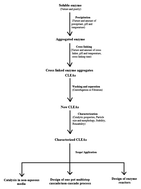Parameters in preparation and characterization of cross linked enzyme aggregates (CLEAs)
Abstract
In the past couple of decades, cross linked enzyme aggregates (CLEAs) have emerged as a novel and versatile carrier free immobilization technique. The immobilization of enzymes as cross linked enzyme aggregates (CLEAs) involves precipitation of an enzyme from aqueous solution followed by cross linking with a bi-functional reagent. It is worth noting that many parameters alter the enzyme precipitation and the aggregate cross linking and hence affect the activity and stability of CLEAs. Therefore to endorse CLEAs for industrial application, each newly synthesised CLEA is characterized. This review intends to investigate the effects of various parameters, such as the nature and purity of the enzyme, the nature and amount of precipitant, the nature and amount of cross linker, the cross linking time, the pH and temperature during CLEA preparation and washing and separation techniques on the activity and stability of CLEAs. The major parameters such as catalytic properties, particle size and morphology, stability and reusability required for approval of industrial applicability of newly synthesized CLEAs are critically reviewed. Furthermore the scope of CLEAs in non-aqueous solvent, the development of one pot cascade processes and the design of different types of enzyme reactors is also discussed.


 Please wait while we load your content...
Please wait while we load your content...